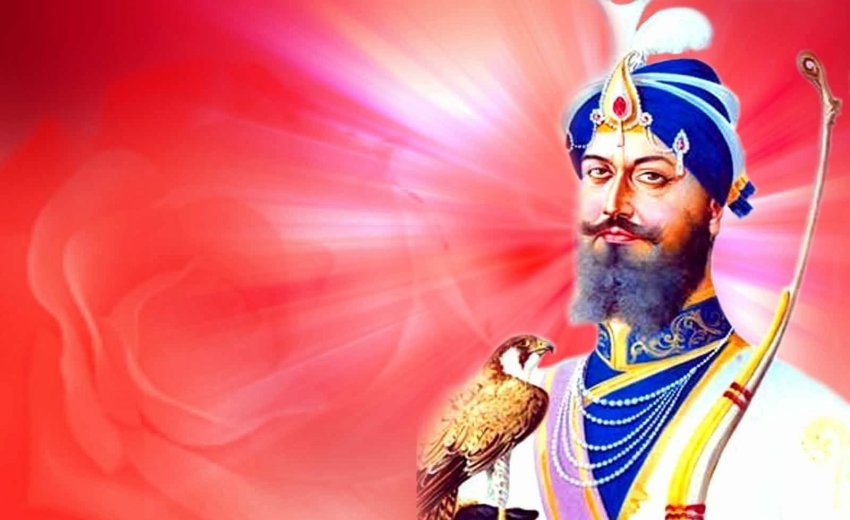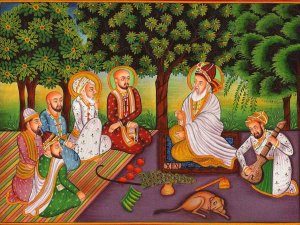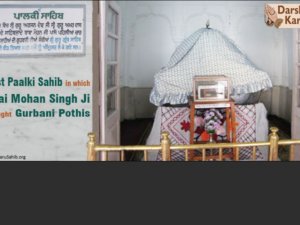Guru Gobind Singh was one of those great men of India whose name will be remembered forever. His name arouses an inspiring interest and produces certain emotions in the mind of every right-minded person. He was a versatile genius and a unique personality of contrasting qualities. He refused to yield to social injustice at the cost of his family and his own life. His greatness stands out brighter as the ages pass. Undoubtedly, he is one of those heroes who strengthened our country and enabled her to stand against oppression. Let us see what he has done for us and what we Indian can learn from him.
National Unity
Guru Gobind Singh did his best so that all sects and communities in India may live with freedom and enjoy the fruit of liberty and equality. He inspired them with sentiments of nationality and nationalism, and the zeal to dare, do and die for the common cause. He wanted to see that they may have unity and fellow feelings so that they may be ready to sacrifice their lives for the sake of their country and stand against the foreign invaders who were bent upon converting them to Islam as stated by a Muslim famous poet, Bulle Shah. Translated version of his poem in Punjabi is being quoted to prove it---‘I do not say of this time, I do not say of that time, had Guru Gobind Singh not been there, all would have been converted to Islam forcibly’.
He reconciled Fateh Shah, the chief of Garhwal state with Medni Parkash, the chief of Nahan state in a bid to unite the Hindu rulers. At Rawalsar, he exhorted the hill chiefs who were fighting among themselves to remain united and face the Mughal oppression. He personally helped them to succeed in their fight against the Mughal army in the battle of Nadaun. He taught Indians that to live and die for the country is the supreme form of religion. According to Gokal Chand Narang, author of Transformation of Sikhism, Under Guru Gobind Singh’s leadership, nationalism itself became a religion.
No doubt, Guru Gobind Singh fired the minds of his countrymen with nationalism. It is wrong to say that he fought against the Hindu hill chiefs and the Muslims. He fought against oppression. He had 500 Pathans in his army and Muslim followers like Pir Buddu Shah who sacrificed his 2 sons, father and many Muslim soldiers helping the Guru in the battle of Bhangani. The Guru regarded all human beings as one and the same:
ਦੇਹਰਾ ਮਸੀਤ ਸੋਈ ਪੂਜਾ ਔ ਨਿਵਾਜ ਓਈ ਮਾਨਸ ਸਬੈ ਏਕ ਪੈ ਅਨੇਕ ਕੋ ਭਰਮਾਉ ਹੈ (Dasam Granth)
“The Temple and the Mosque are the same; there is no difference between them. Neither is there any dissimilarity between the Hindu worship and the
Muslim namaz (prayer). The whole human race is the same but due to illusion, they appear different”.
It is apparent from the above that the Guru was not against the Muslims, rather he was very friendly to like minded Muslims. So much so that he created friendship with Bahadur Shah s/o Aurangzeb and on his request the Guru helped him in getting the throne of the Mughal Empire. His friendship with Bahadur Shah is quite evident from the Gurdwara Damdama Sahib in Delhi near the Humayan Tomb.
Recruitment to Armed Forces (Creation of the Khalsa)
Circumstances in the country had changed greatly; India was under the ruthless bigot Aurangzeb and there was no constitution which could protect people from his brutality. Under him, the Hindus who were no more a living race had no legal rights, their temples were burnt and they had become cowards. Guru Gobind Singh perceived that the times had changed, and was consequently determined to keep pace with the time. He saw that the passive conservatism of his ecclesiastical predecessors was not suited to the time. He created an army of saint soldiers and infused in the mind of his followers the spirit of confidence and courage. His aim was freedom of the country from foreign forces and independence of the country. He staged a monodrama on the Baisakhi day in 1699 and created saint soldiers (Khalsa), pure hearted lifelong devoted soldiers, to awaken the dormant spirit of his followers. Sword became a substitute for rosary in their hands. It was to strike terror in the heart of the oppressor and to protect the oppressed. With the apparent symbols, the Khalsa could not hide his identity and had no chance of survival if he managed to evade the enemy.
The creation of the Khalsa was one of his four acts of crowning glory. It speaks of originality and creativity of a matured brain. Cunningham, a famous historian, was right when he wrote: By the creation of the Khalsa, Guru Gobind Singh aroused the defeated masses and filled in them the high ideals of social freedom and national pride. Recruitment was without any distinction of caste, creed, religion or area of residence. Three of his five beloveds belonged to the weaker section of the society. He proved that all races fight
equally well if they are provided with good leadership and a just mission. It was the birth of a new nation. Every baptized Sikh became a Singh, a lion, armed to teeth. He had to sip Amrit from the same vessel, thereby joining them in eternal brotherhood and casting away the barrier of caste or creed. Everyone was bound with a code of conduct. He said,“ The Sikh living is dear to me not a Sikh in Name.”
ਹੰਦੂ ਤੁਰਕ ਕੋਊ ਰਾ ਫਜੀ ਇਮਾਮ ਸਾ ਫੀ ਮਾਨਸ ਕੀ ਜਾਤ ਸਬੈ ਏਕੈ ਪਹਿਚਾਨਬੋ (Dasam Granth:47)
‘Some are Hindus and others are Muslims. Someone is lliifazi (ashiah=renouncer- follower of Ali) and another an Imam-Shafi (Sunni=adherent of the Prophet), but ye recognize all human race as one. ’
Self Defense and not Aggression
In the short span of his life of less than 42 years (41 years 10 months and 12 days), Guru Gobind Singh had to fight many battles, but none was started by the Guru who taught us the concept of self defense. He wanted that one should try sincerely to steel oneself to defend oneself from the evil forces, so he got built forts at Anandpur Sahib. He took arms when all other means failed. In the words of the Guru:
ਚੁ ਕਾਰ ਅਜ਼ ਹਮਹ ਹੀਲਤੇ ਦਰ ਗੁਜ਼ਸ਼ਤ ॥
ਹਲਾਲ ਅਸਤ ਬੁਰਦਨ ਬ ਸ਼ਮਸ਼ੀਰ ਦਸਤ ॥ (Dasam Granth: 1730 )
‘When an affair outstrips all machinations; i t is legitimate to grip the hilt of the sword.’
Service before Self
Undoubtedly there is no example in the annals of history where from one family alone so many self-less sacrifices have been made with the aim to upgrade the people socially, morally, and spiritually. He sacrificed his father, mother, sons and Sikhs. When the Guru’s consorts joined him at Damdama Sahib and said “,Where are my children?” Pointing to the congregation, he said “, Here are scores of them, all are your children.”The Guru’s life was busy with no
desire to create a kingdom, to rest or leisure. A sincere effort to promote the happiness of others was a sacred mission for the Guru.
Humility and Temperance
Another good thing that we can learn from the Guru’s life is to remain humble and not to be elated when success licks our feet, and not to feel dejected when our efforts fail. He created an example of humility when he knelt before his five beloveds and requested to be baptized. Thus he gave his people a new status superior to himself. He advised his followers not to treat him as God. He considered himself an ordinary man of God. He was humble enough to give the credit of his achievements to his followers:
ਜੇ ਹਮ ਕੋ ਪਰਮੇਸਰ ਉਚਰਿ ਹੈ ॥ ਤੇ ਸਭ ਨਰਕ ਕੁੰਡ ਮਹਿ ਪਰਿ ਹੈ ॥ ਮੋ ਕੌ ਦਾਸ ਤਵਨ ਕਾ ਜਾਨੋ ॥ ਯਾ ਮੈ ਭੇਦ ਨ ਰੰਚ ਪਛਾਨੋ ॥
ਮੈ ਹੋ ਪਰਮ ਪੁਰਖ ਕੋ ਦਾਸਾ ॥ ਦੇਖਨ ਆਯੋ ਜਗਤ ਤਮਾਸਾ ॥ (Dasam Granth:132)
‘Those who call me God will fall into the pit of hell . Consider me as His (the Immortal Lord's) servant, Understand that there is not one iota of discrepancy in this statement. I am servant to the Supreme Lord. And have come to witness the pageant of this world.’
ਇਨਹੀ ਕੀ ਕ੍ਰਿਪਾ ਕੇ ਸਜੇ ਹਮ ਹੈਂ ਨਹੀਂ ਮੋ ਸੋ ਗਰੀਬ ਕਰੋਰ ਪਰੇ ॥ (Dasam Granth 1))
‘It is through their( follower’s) aid that I have attained this status, otherwise there are millions of unknown mortals like me.’
A Unique Personality
Guru Gobind Singh was not a ruler yet he ruled the hearts of the people through the force of his moral character. He was a true socialist in thought, word and deed. Never before Guru Gobind Singh, a child of 9 requested his father to go and offer his head for the sake of his oppressed countrymen whose religious freedom was in danger. He directed his young sons to fight against heavy odds, where death was certain. Never before has any leader sacrificed everything dear to him without any remorse. Never before has any religious leader knelt before his followers and treated them as superior to himself, and never before has any general fought battles himself like Guru Gobind Singh did. 200 years before Hentry Dunant, the Guru started the movement of Red Cross by supplying ointment and bandages to Bhai Kanhiya for dressing the injured soldiers without considering their religion. To him, it was a sin to bow before tyranny and righteousness to take up arms against the tyrants He reconciled the cult of sword with spiritual values. He succeeded in convincing the masses that the destiny of a nation changes only when people themselves make an effort to alter it. He blended the courage of the soldier with the enthusiasm of a devotee. He projected the concept that weapons were the medium of worship of God. Under his leadership, the cows o f Guru Nanak’s time had become lions. He converted undisciplined persons given to plunder and agriculture pursuits into a force of disciplined soldiers. Under his able leadership, a handful section of the society humbled the so-called invincible power of the Mughals.
Conclusion
India can learn a lot from Guru Gobind Singh. He made his countrymen conscious of nationalism, freedom and democracy. He taught us the lesson of self-defense and to face tyranny with force. The example of Guru Gobind Singh’s sacrifices is like a beacon light for all the political, social and religious leaders for all times to come. His example as a religious, military and social leader shines like a brilliant star on the horizon. No doubt, lessons taught by Guru Gobind Singh are timeless. Had the hill chiefs followed his advice and not opposed him, India would have become independent 250 years earlier. About the struggles of the Guru’s life, the words of Cunningham, “Success is not always the measure of one’s greatness”, are most befitting. He taught the vanquished political Indians how to obtain political ascendancy and national freedom. Our men in uniform can learn a lot from the experience of Guru Gobind Singh in all fields of military leadership viz., Training, Discipline, Motivation and Character building. His concept of operational ready at all times (Tayar bar tayar) is of immense significance for us. His example will inspire Indians to do heroic deeds. His character is an ideal example worth emulating and inculcating. His concept of impersonal victory viz’ (Waheguru ji ke Fateh) teaches us that vanity and pride should not overpower us. Living example of great men like Guru Gobind Singh can enable our country to stand against oppression forever.






